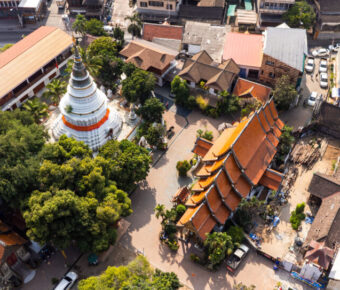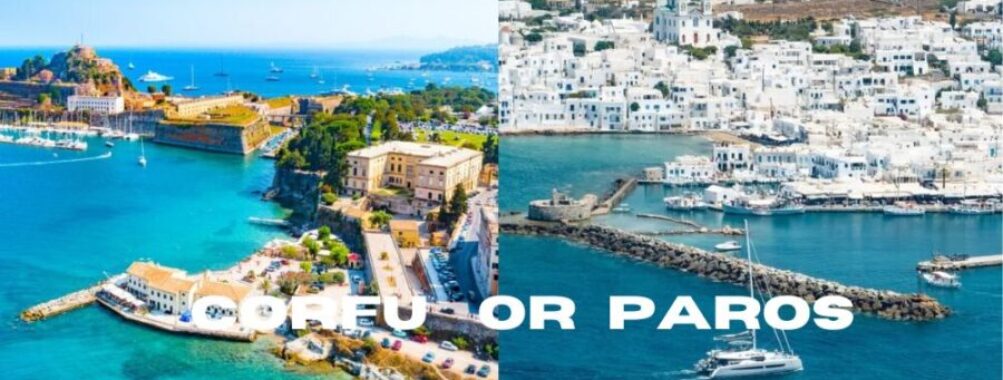
Corfu vs Paros: Which Greek Paradise Offers the Better Island Experience in 2025
Choosing between Corfu and Paros can feel like picking between two perfect slices of Greek paradise. These islands offer very different takes on the Mediterranean dream, each with its own special magic.
Corfu is five times bigger than Paros and brings a mix of Italian and British influences to its Greek roots, while Paros offers a more traditional Cycladic experience with its white-washed villages and quieter vibe. The choice comes down to what kind of Greek adventure travelers want to create.
These gems of the Greek seas draw visitors year after year with their stunning beaches and crystal-clear waters. Corfu shines with its lush green landscapes and historic Old Town, while Paros charms with its traditional fishing villages and world-class windsurfing spots.
Contents
- Geographic Overview
- Location of Corfu and Paros
- Climate and Landscape
- Cultural and Historical Significance
- Historical Timeline of Corfu
- Cultural Heritage of Paros
- Travel and Accessibility
- Getting to Corfu
- Exploring Paros
- Accommodation Options
- Hotels and Resorts in Corfu
- Staying in Paros
- Beaches and Natural Attractions
- Best Beaches in Corfu
- Natural Beauty of Paros
- Gastronomy and Dining Experiences
- Eating Out in Corfu
- Culinary Delights of Paros
- Leisure and Entertainment
- Nightlife and Parties in Corfu
- Family-Friendly Fun in Paros
- Adventure and Outdoor Activities
- Hiking and Trails in Corfu
- Water Sports in Paros
- Local Lifestyle and Traditions
- Village Life in Corfu
- Traditions of Paros
- Frequently Asked Questions
- What are the distinct differences in tourist attractions between Corfu and Paros?
- How does the nightlife compare in Corfu to that in Paros?
- Can you highlight the differences in the culinary experience when visiting Corfu versus Paros?
- What should travelers consider regarding the beaches when choosing between Corfu and Paros?
- Could you describe the cultural and historical contrasts between Corfu and Paros?
- What are the transportation options when traveling to and around Corfu as opposed to Paros?
- More Travel Guides
Geographic Overview
Corfu and Paros sit in different Greek seas, giving each island its own distinct character. While Corfu shines as a green jewel in the Ionian Sea, Paros sparkles as a typical Cycladic gem in the Aegean waters.
Location of Corfu and Paros
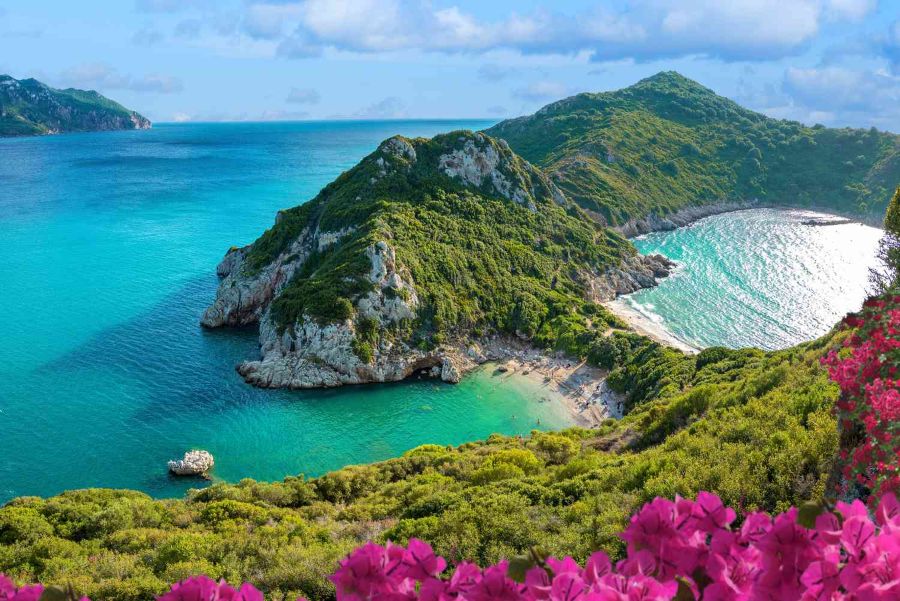
Corfu rests off Greece’s northwestern coast in the Ionian Sea, close to Albania and Italy. Its unique position made it a strategic crossroads throughout history, leading to strong Venetian and Italian influences in its architecture and culture.
Paros lies in the heart of the Cyclades island group in the Aegean Sea. The island sits between Mykonos and Santorini, making it a perfect base for island hopping. Its central location in the Aegean makes it easy to reach from Athens.
Climate and Landscape
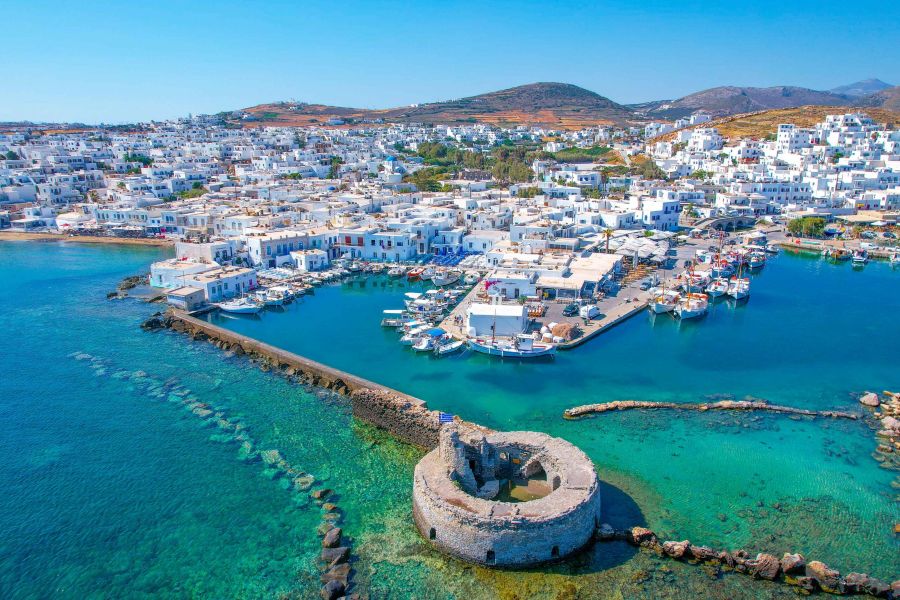
Corfu benefits from a mild Mediterranean climate with plenty of rainfall, giving it lush, green vegetation. The island features rolling hills, olive groves, and cypress trees. Its coastline alternates between sandy beaches and dramatic cliffs.
Paros shows off the classic Cycladic landscape with dry, rocky terrain and white cubic buildings. The island enjoys hot, sunny summers and mild winters. Strong winds called meltemi sweep through during peak summer months.
The mountains of Paros reach up to 771 meters at Mount Profitis Ilias. Small valleys dotted with vineyards and fig trees break up the rocky landscape.
Beautiful sandy beaches ring both islands, though Paros tends to have more secluded coves and smaller beach spots.
Cultural and Historical Significance
Both islands showcase rich cultural traditions and fascinating historical legacies that stretch back thousands of years, with ancient ruins, notable architecture, and deep artistic roots.
Historical Timeline of Corfu
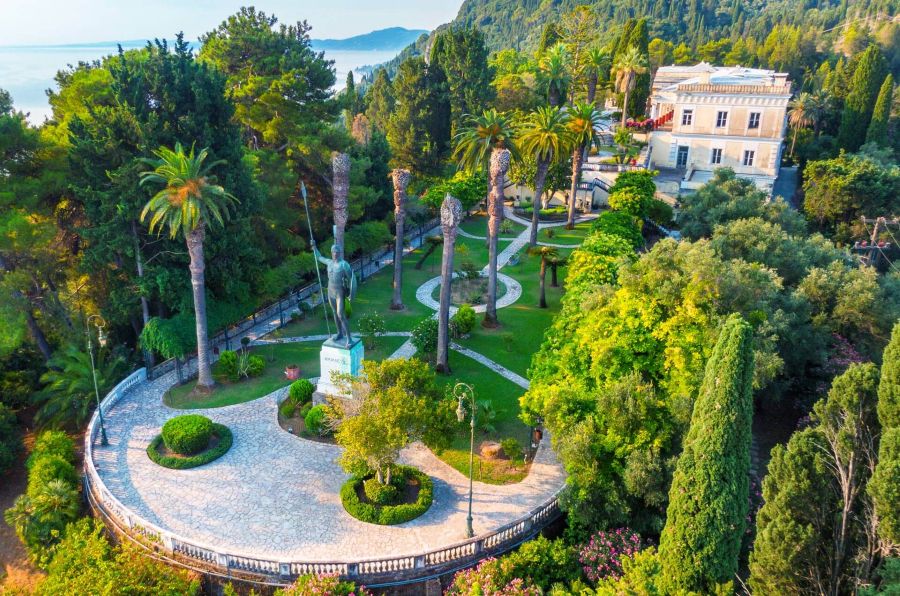
The Venetians ruled Corfu for over 400 years, leaving behind stunning architecture and fortifications still visible today. The Old Town, now a UNESCO World Heritage site, reflects this unique blend of Greek and Italian influences.
The Achilleion Palace stands as a testament to Corfu’s royal connections. Built in 1890 for Empress Elisabeth of Austria, its beautiful gardens and classical Greek statues draw visitors year-round.
The island’s strategic location made it a target for many invaders. The British, French, and Russians all left their mark on Corfu’s culture, creating a fascinating mix of architectural styles and traditions.
Cultural Heritage of Paros
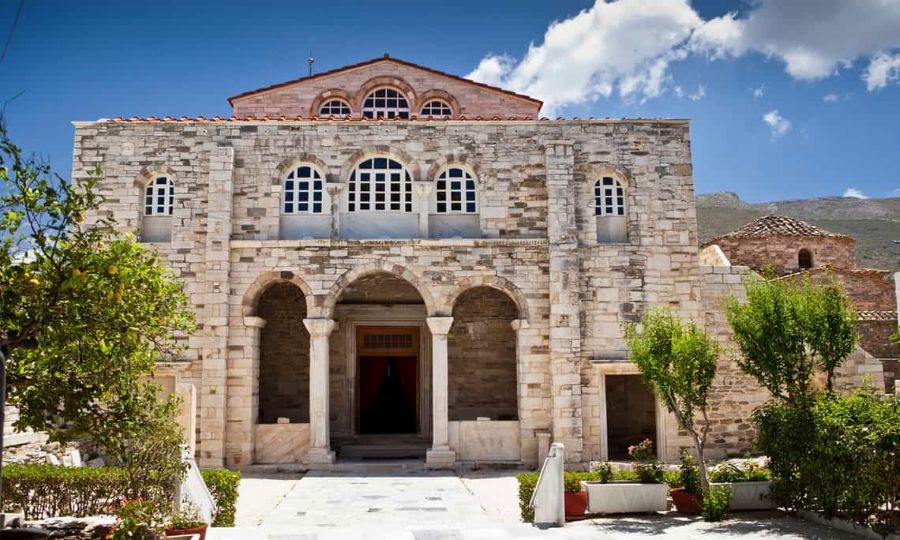
Parian marble, famous for its exceptional quality and pure white color, helped build many ancient masterpieces. The Venus de Milo and Napoleon’s tomb were carved from this precious stone.
The Church of Panagia Ekatontapiliani, also known as the Church of 100 Doors, dates back to the 4th century. Its Byzantine architecture and religious significance make it one of Greece’s most important churches.
The Archaeological Museum in Parikia houses impressive artifacts from the island’s past. Ancient sculptures, pottery, and daily life items tell the story of Paros’s role in Classical Greek civilization.
The traditional villages maintain their Cycladic character with white-washed buildings and blue-domed churches.
Travel and Accessibility
Getting to and around these Greek islands requires different transportation methods. Each destination has its own unique set of travel options that shape the visitor experience.
Getting to Corfu
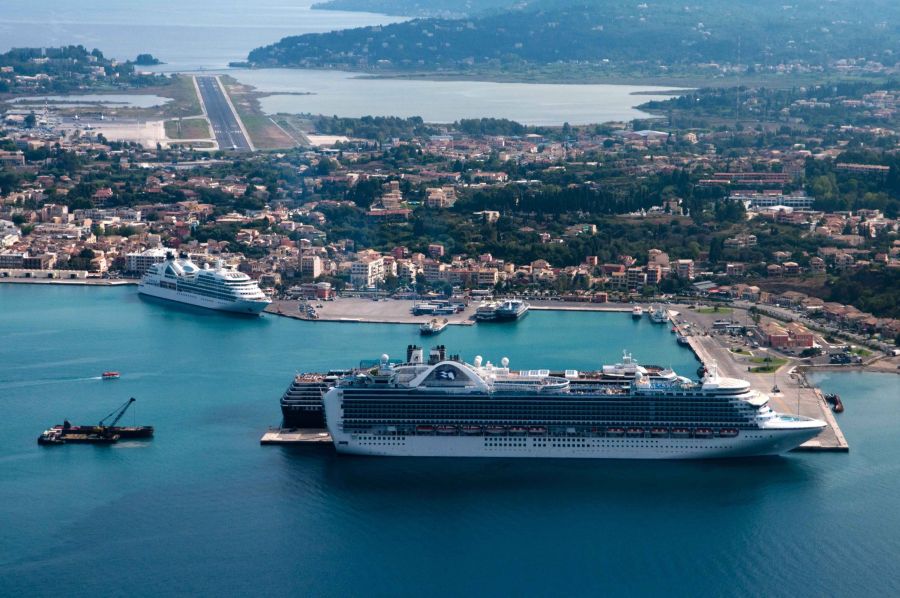
Corfu sits in the northern Ionian Sea, making air travel the most popular choice. The island’s international airport welcomes flights from many European cities year-round. During peak season, dozens of airlines offer direct flights from major hubs.
Reaching Corfu by sea means taking a ferry from mainland Greece or Italy. Regular ferry services run from Igoumenitsa on the Greek mainland – a trip that takes about 90 minutes. Longer routes connect Corfu to Italian ports like Bari and Brindisi.
Exploring Paros
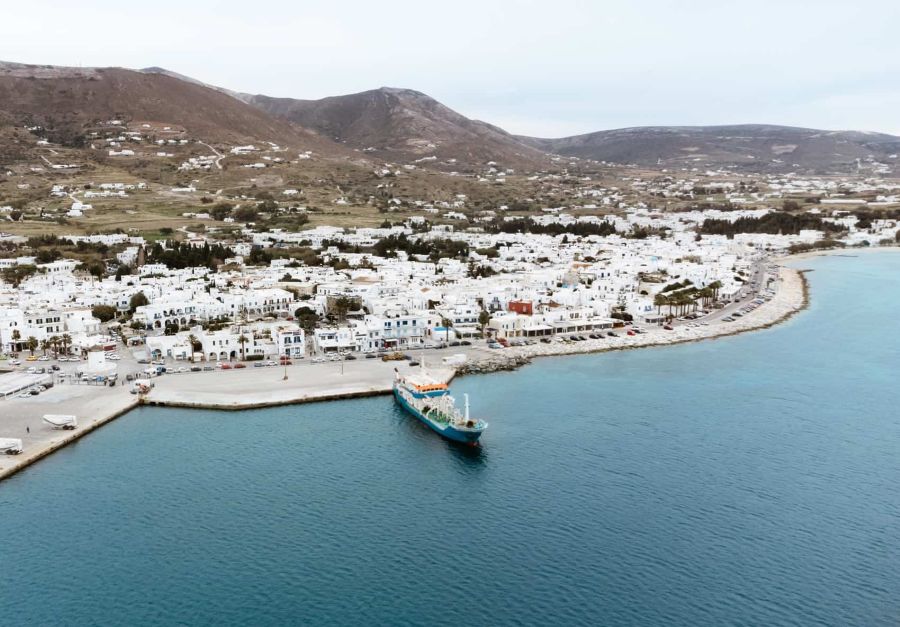
Paros connects to Athens through frequent ferries and small planes. The island’s small airport handles domestic flights, with trips from Athens taking just 40 minutes.
The most common way to reach Paros is by ferry from Piraeus port. Fast ferries make the journey in about 3 hours, while regular ferries take 4-5 hours. The island’s central location in the Cyclades makes it easy to visit nearby islands like Naxos and Santorini.
Local buses run between main towns and beaches on Paros. Taxis, rental cars, and scooters give visitors flexible transport options for exploring the island’s villages and hidden coves.
Accommodation Options
Both islands offer distinct lodging experiences, from luxury resorts to cozy boutique properties that showcase Greek hospitality and charm.
Hotels and Resorts in Corfu
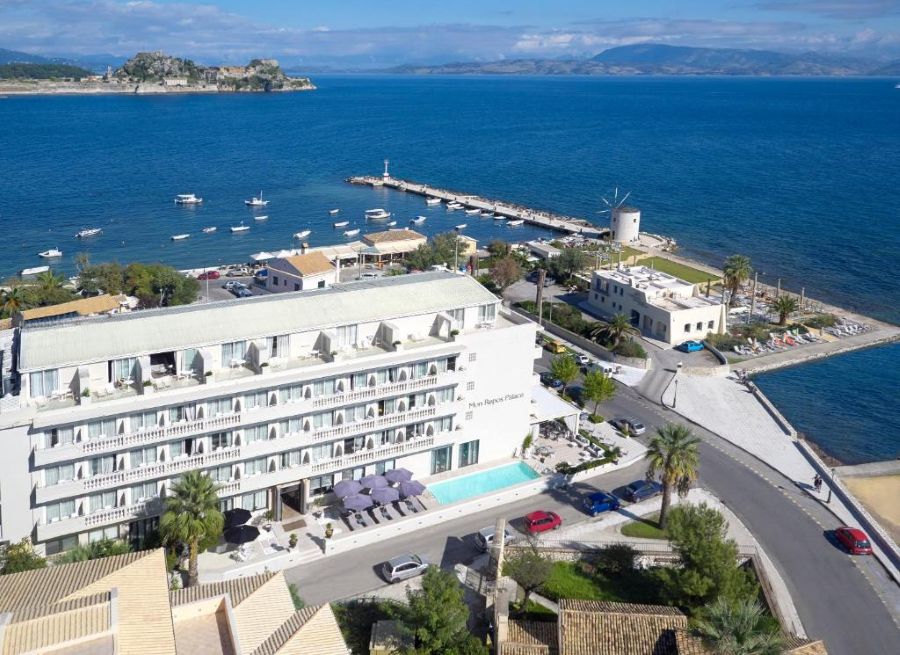
Corfu’s accommodation scene sparkles with elegant options. The Mayor Mon Repos Palace Art Hotel stands as a prime example of luxury lodging in Corfu Town, mixing modern comforts with classic style.
The island’s north coast features upscale beach resorts with private beaches and pools. Many properties offer stunning views of the Ionian Sea and easy access to popular attractions.
[Book your Corfu hotel] stretches your vacation budget with choices ranging from 5-star resorts to family-run guesthouses.Rodostamo Hotel & Spa represents the premium end of Corfu’s offerings, with world-class amenities and exceptional service.
Staying in Paros
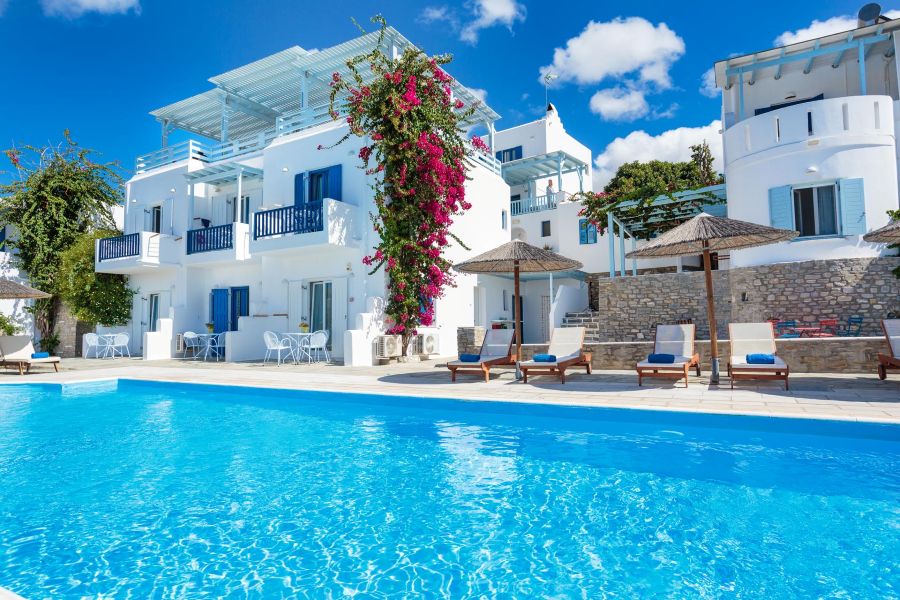
Paros delivers authentic Greek charm through its accommodations. The Argonauta Hotel captures this spirit perfectly, located minutes from the port with a lovely courtyard setting.
Blue Waves Suites provides a peaceful retreat on Drios Beach. Each room opens to private balconies with sea views.
Beach hotels dot the coastline near Naoussa and Parikia. These spots give easy access to swimming and water sports.
Small, family-owned properties make up most of Paros’s lodging options. They tend to be more intimate and personal than Corfu’s larger resorts.
Beaches and Natural Attractions
Both Greek islands offer incredible coastal landscapes with crystal-clear waters and unique natural features that make them perfect for beach lovers and nature enthusiasts.
Best Beaches in Corfu
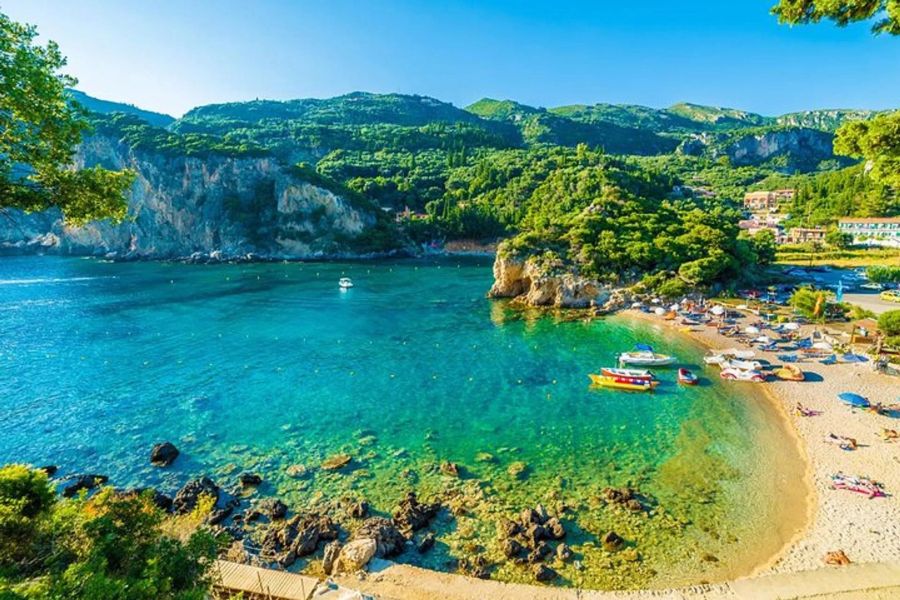
Paleokastritsa stands out as Corfu’s crown jewel, with six stunning blue-water coves surrounded by olive groves and cypress trees. The calm waters make it perfect for swimming and snorkeling.
Canal d’Amour features unique rock formations creating natural swimming pools. Legend says couples who swim here will stay together forever.
Glyfada Beach draws visitors with its golden sand and perfect waves for water sports. The beach has excellent facilities and beachfront tavernas.
Hidden gems like Rovinia Beach reward adventurous travelers with pristine waters and peaceful surroundings. You’ll need to hike down a path to reach this secluded paradise.
Natural Beauty of Paros
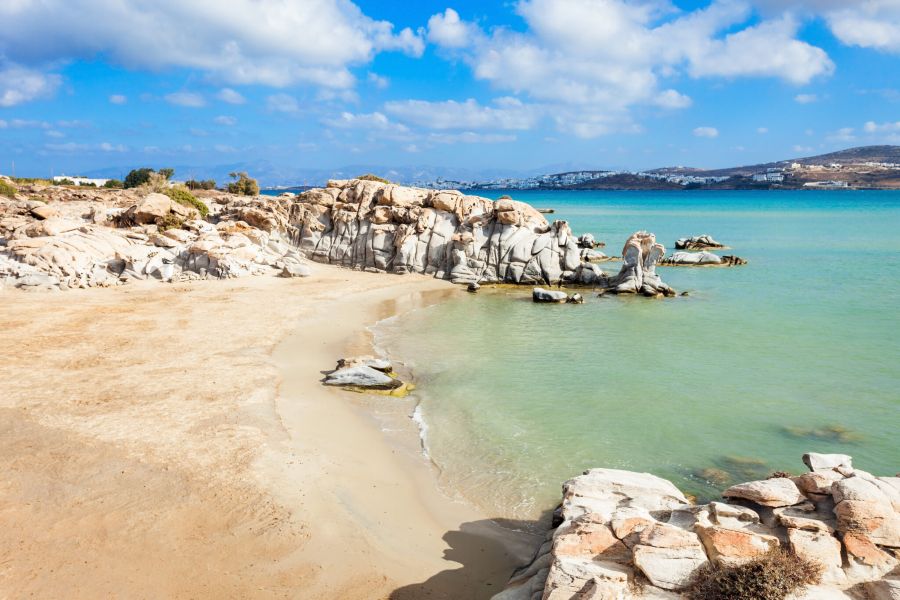
Kolymbithres Beach showcases unique granite rock formations shaped by wind and waves over millions of years. The smooth rocks create natural swimming pools between small sandy coves.
Santa Maria Beach offers crystal-clear waters perfect for snorkeling, with small fish darting around your feet. The beach features soft sand and shallow waters.
Golden Beach stretches for nearly a kilometer, making it Paros’s longest beach. Its consistent winds attract windsurfers from around the world.
The small cove of Monastiri provides a peaceful escape with its clear waters and striking rock formations. The nearby monastery adds to its charm.
Gastronomy and Dining Experiences
Greek cuisine shines brightly on both islands, with each destination offering unique flavors and dining experiences that reflect their distinct cultural heritage and local ingredients.
Eating Out in Corfu

Corfu’s food scene blends Greek and Italian influences thanks to its Venetian heritage. The island’s signature dish is pastitsada, a rich pasta dish with rooster or beef in a spicy tomato sauce. Local tavernas serve fresh catches like sardines and sea bream.
The city’s Old Town features countless family-run restaurants in charming stone buildings. Try sofrito, tender veal cooked in wine sauce with garlic and herbs. The local kumquat liqueur makes a perfect after-dinner treat.
Street food stalls offer quick bites like bougatsa, a crispy phyllo pastry filled with custard. Many restaurants have outdoor seating in peaceful courtyards draped with grapevines.
Culinary Delights of Paros
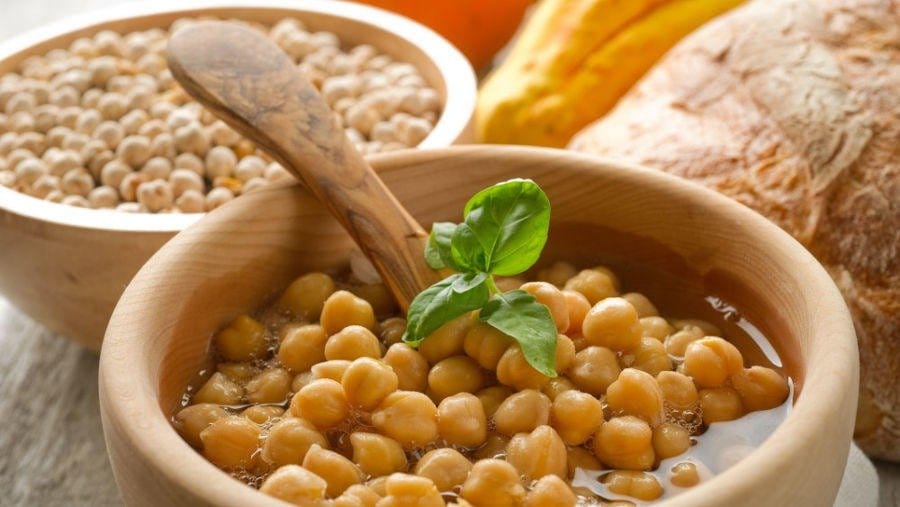
Paros delivers authentic Cycladic cuisine centered on fresh seafood and local ingredients. The fishing village of Naoussa is famous for its waterfront restaurants serving octopus, grilled sardines, and kakavia fish soup.
The mountain villages offer hearty dishes like revithada, traditional chickpea stew slow-cooked in clay pots. Local cheese is a highlight – try the tangy xinomizithra made from goat’s milk.
Barbarossa restaurant in Naoussa serves refined Mediterranean dishes using fresh catches. The island’s white eggplant is prized for its sweet flavor and features in many traditional recipes.
Beach tavernas dot the coastline, perfect for casual meals of Greek salad and grilled fish while watching the sunset. Local wine from Paros vineyards pairs wonderfully with the island’s cuisine.
Leisure and Entertainment
Corfu and Paros each offer distinct entertainment scenes that cater to different types of travelers. The islands contrast sharply in their nightlife energy and family activities.
Nightlife and Parties in Corfu

Corfu’s vibrant party scene centers around the famous Kavos strip, packed with neon-lit bars and dance clubs that stay open until sunrise. The music ranges from Greek bouzouki to international EDM.
Beach clubs dot the coastline, with Pink Palace and Atlantis being local favorites for sunset cocktails and DJ sets. You’ll find themed parties during peak season from June to September.
The old town comes alive at night with traditional tavernas hosting live Greek music and dancing. Many spots offer kefi – the Greek spirit of joy and fun – with plate-smashing and local dance lessons.
Family-Friendly Fun in Paros
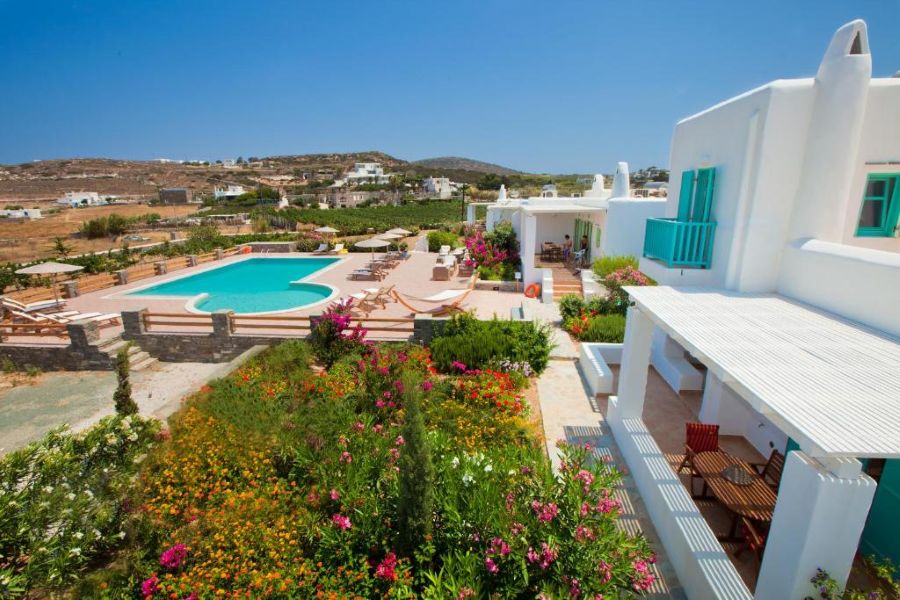
Paros shines with its gentle, kid-friendly activities. The Aqua Paros Water Park features slides and pools perfect for all ages, while organized beach activities keep children entertained.
Local operators run sailing lessons specially designed for families. Kids can learn basic navigation while exploring the calm waters around Naoussa Bay.
The Environmental and Cultural Park offers guided nature walks and traditional craft workshops. Children love feeding the park’s friendly farm animals and learning about local ecology.
Traditional fishing villages like Piso Livadi host puppet shows and street performers during summer evenings, creating magical memories for young visitors.
Adventure and Outdoor Activities
Both Corfu and Paros shine when it comes to outdoor adventures, with each island offering unique experiences shaped by their distinct landscapes and coastlines.
Hiking and Trails in Corfu
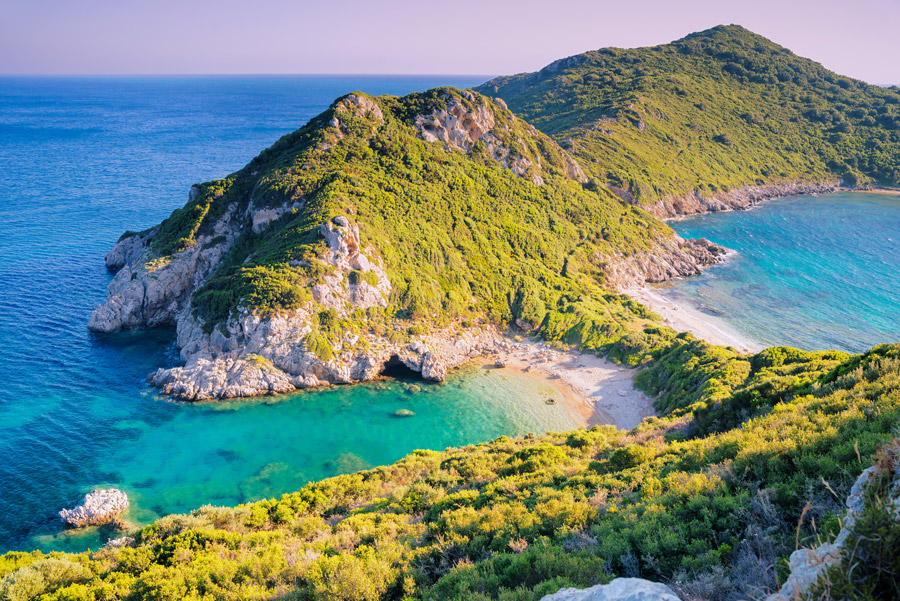
The ancient Corfu Trail spans 220 kilometers across the island, passing through olive groves and traditional villages. The rugged northern mountains create perfect hiking conditions, while the Erimitis Peninsula features shorter nature walks through untouched coastal paths.
Water Sports in Paros
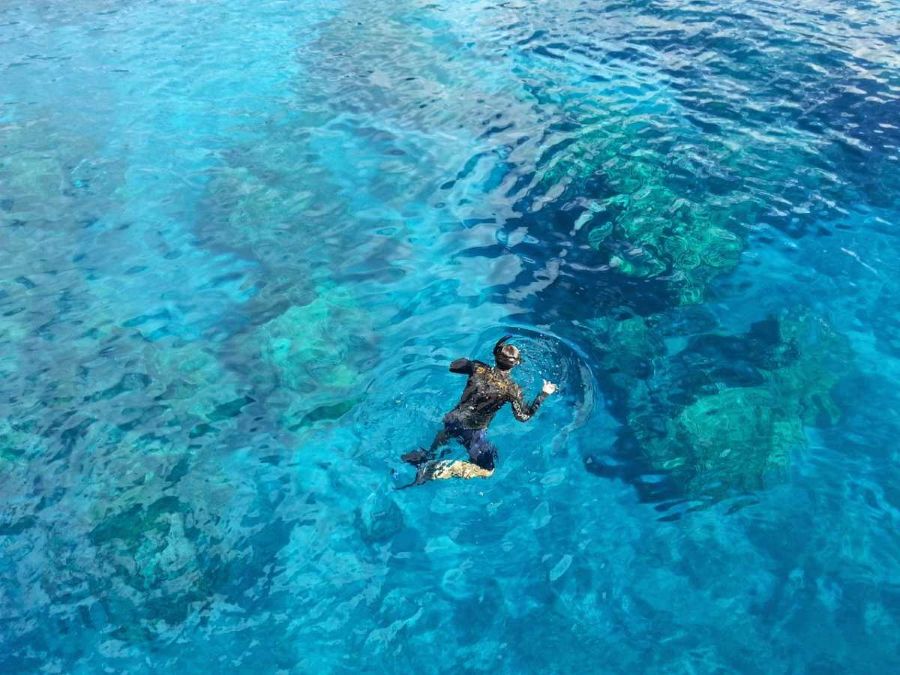
Paros ranks among Greece’s top water sports destinations thanks to its steady winds and crystal waters. Golden Beach and New Golden Beach attract windsurfers from around the world.
The calm morning waters near Naoussa Bay create ideal conditions for paddleboarding and kayaking. Local shops rent equipment and offer lessons for beginners.
Snorkeling spots dot the coastline, with the best sites near Kolimbithres Beach. The unique rock formations shelter colorful fish and sea life.
Santa Maria Beach has become the island’s kitesurfing hub. The consistent summer winds make it perfect for both beginners and experienced riders.
Local Lifestyle and Traditions
Life on these Greek islands moves at a gentle pace, where age-old customs shape daily routines and create rich cultural experiences for visitors who want to learn about island living.
Village Life in Corfu
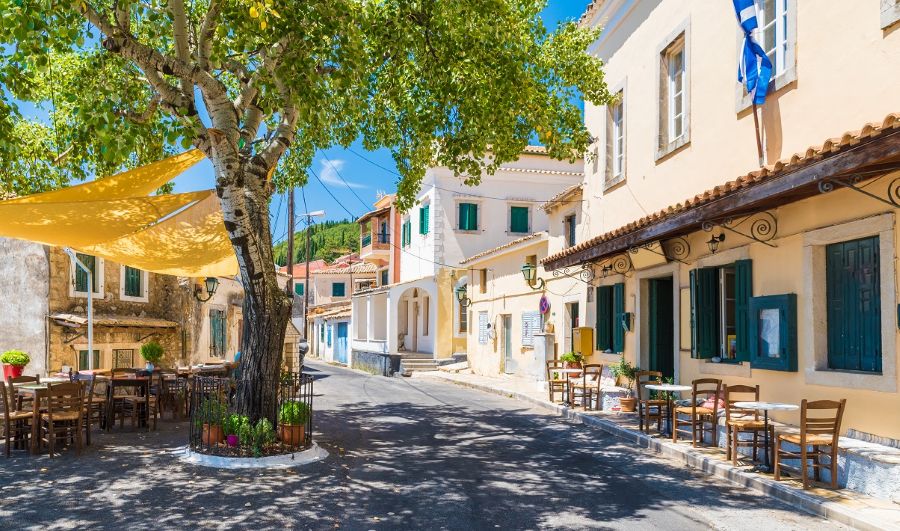
The villages of Corfu keep time-honored traditions alive. Locals start their days early, walking to nearby bakeries for fresh bread and stopping to chat with neighbors along the way. The streets come alive in the late afternoon when families gather in town squares.
Stone buildings with red-tiled roofs line narrow cobblestone streets. Elderly residents often sit outside their homes, sharing stories and watching village life unfold.
Food plays a big role in bringing people together. Extended families meet for long lunches that stretch into the evening. Many households still make their own olive oil and wine.
Religious festivals happen year-round in Corfu’s villages. Easter is extra special, with candlelit processions and pot-throwing ceremonies that date back centuries.
Traditions of Paros

Village life in Paros centers around pristine white Cycladic buildings and blue-domed churches. The maze-like streets were designed to confuse pirates in ancient times.
Local women still practice traditional crafts like weaving and embroidery. You’ll spot handmade textiles hanging from balconies and in shop windows.
Fish markets buzz with activity in the early morning as boats return with fresh catches. Many families maintain small farms where they grow olives, figs, and grapes just as their ancestors did.
Summer brings the panigiri – traditional village festivals with live Greek music, dancing, and local specialties like grilled octopus and souvlaki. These celebrations often last until sunrise.
Frequently Asked Questions
Corfu and Paros offer distinct experiences from beaches to culture, making them unique destinations for different types of travelers. Each island brings its own charm to create memorable Greek vacations.
What are the distinct differences in tourist attractions between Corfu and Paros?
Corfu features grand Venetian architecture, including the UNESCO-listed Old Town with its fortress and palaces. The island’s lush green landscapes and olive groves set it apart from other Greek islands.
Paros focuses on traditional Cycladic charm with whitewashed buildings and blue-domed churches. The village of Naoussa draws visitors to its fishing harbor, while the marble quarries showcase the island’s ancient industry.
How does the nightlife compare in Corfu to that in Paros?
Corfu’s nightlife centers around Kavos and Corfu Town, with large clubs and music venues that stay open until sunrise. The island attracts a younger crowd during peak season.
Paros offers a more laid-back evening scene. Small bars and tavernas in Naoussa and Parikia provide live Greek music and casual drinks by the water.
Can you highlight the differences in the culinary experience when visiting Corfu versus Paros?
Corfu’s cuisine shows strong Italian influences, with dishes like pastitsada and sofrito. Fresh seafood and local olive oil feature prominently in most meals.
Paros emphasizes traditional Greek island cooking. Local specialties include fresh fish, gouna (sun-dried mackerel), and regional cheese varieties.
What should travelers consider regarding the beaches when choosing between Corfu and Paros?
Corfu’s beaches vary from long sandy stretches to hidden pebble coves. The west coast offers dramatic cliffs and sunset views, while the east coast provides calmer waters.
Paros features golden sand beaches with crystal-clear waters. Popular spots like Golden Beach attract windsurfers, while secluded coves offer quiet swimming spots.
Could you describe the cultural and historical contrasts between Corfu and Paros?
Corfu’s history reflects strong Venetian, French, and British influences. The island’s museums and architecture tell stories of European occupation and Greek resistance.
Paros maintains its traditional Cycladic identity. Ancient marble quarries, Byzantine churches, and preserved villages showcase Greek island heritage.
What are the transportation options when traveling to and around Corfu as opposed to Paros?
Corfu has an international airport with direct flights from many European cities. Buses and taxis serve the main towns, while rental cars help explore remote areas.
Paros requires travel through Athens or other Greek islands by ferry or small aircraft. The local bus network connects major villages, and rental scooters work well for beach-hopping.
